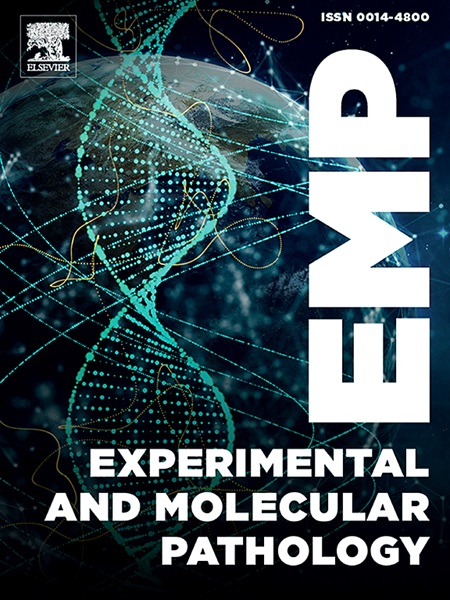The effects of melatonin on differentiated C2C12 myotubes in the absence of pathology: An oxygen-sparing action and enhancement of pro-survival signalling pathways
IF 3.7
4区 医学
Q2 PATHOLOGY
引用次数: 0
Abstract
Previous research has demonstrated that melatonin protects against muscle damage while also improving the performance of injured muscle. However, its impact on healthy skeletal muscle remains largely unexplored. We exposed differentiated C2C12 myotubes to two melatonin concentrations (10 nM or 50 nM). The 10 nM concentration did not affect any of the mitochondrial respiration parameters. Whereas 50 nM concentration reduced mitochondrial complex II-linked oxidative phosphorylation (OXPHOS), electron transfer system (ETS) capacity, the contribution of complex II to ETS, and residual oxygen consumption (ROX). Neither concentration influenced the mitochondrial coupling control ratios, nor the coupling control efficiency ratios. Furthermore, neither concentration affected ATP production but reduced superoxide dismutase activity. The 50 nM increased catalase activity without affecting autophagy or citrate synthase activity. Moreover, 50 nM reduced activated JAK2 and STAT3 protein expression, while 10 nM reduced JAK2 without affecting STAT3. Th 50 nM increased activated AKT and ERK1/2 expression with no effect on p38 or PGC1-α expression. Our data suggests that melatonin (50 nM) triggers an oxygen-sparing effect on mitochondrial respiration, which is mediated via its antioxidant actions and its ability to enhance pro-survival pathways. Therefore, melatonin intake may have ergogenic effects on healthy muscles, in the absence of pathology, e.g., consumption before sporting events or physical exercise may aid in the reduction of oxidative stress often associated with such activities. However, this is an in vitro study, and therefore, the clinical relevance of the data should be considered with caution.
褪黑素对无病理分化的C2C12肌管的影响:保氧作用和促生存信号通路的增强
以往的研究表明,褪黑激素能防止肌肉损伤,同时还能提高受伤肌肉的性能。然而,褪黑激素对健康骨骼肌的影响在很大程度上仍未得到研究。我们将分化的 C2C12 肌管暴露于两种浓度(10 nM 或 50 nM)的褪黑激素。浓度为 10 nM 的褪黑激素不影响线粒体呼吸的任何参数。而 50 nM 浓度则降低了线粒体与复合体 II 相关的氧化磷酸化(OXPHOS)、电子传递系统(ETS)能力、复合体 II 对 ETS 的贡献以及剩余耗氧量(ROX)。两种浓度都不会影响线粒体耦合控制比率或耦合控制效率比率。此外,两种浓度都不影响 ATP 的产生,但降低了超氧化物歧化酶的活性。50 nM 会提高过氧化氢酶的活性,但不会影响自噬或柠檬酸合成酶的活性。此外,50 nM 降低了活化的 JAK2 和 STAT3 蛋白表达,而 10 nM 则降低了 JAK2,但不影响 STAT3。Th 50 nM 增加了活化的 AKT 和 ERK1/2 的表达,但对 p38 或 PGC1-α 的表达没有影响。我们的数据表明,褪黑素(50 nM)会对线粒体呼吸产生保氧作用,这种作用是通过其抗氧化作用和增强促生存途径的能力介导的。因此,在没有病变的情况下,摄入褪黑素可能会对健康肌肉产生促进作用,例如,在体育赛事或体育锻炼前摄入褪黑素可能有助于减少与此类活动相关的氧化应激。不过,这是一项体外研究,因此应谨慎考虑数据的临床相关性。
本文章由计算机程序翻译,如有差异,请以英文原文为准。
求助全文
约1分钟内获得全文
求助全文
来源期刊
CiteScore
8.90
自引率
0.00%
发文量
78
审稿时长
11.5 weeks
期刊介绍:
Under new editorial leadership, Experimental and Molecular Pathology presents original articles on disease processes in relation to structural and biochemical alterations in mammalian tissues and fluids and on the application of newer techniques of molecular biology to problems of pathology in humans and other animals. The journal also publishes selected interpretive synthesis reviews by bench level investigators working at the "cutting edge" of contemporary research in pathology. In addition, special thematic issues present original research reports that unravel some of Nature''s most jealously guarded secrets on the pathologic basis of disease.
Research Areas include: Stem cells; Neoangiogenesis; Molecular diagnostics; Polymerase chain reaction; In situ hybridization; DNA sequencing; Cell receptors; Carcinogenesis; Pathobiology of neoplasia; Complex infectious diseases; Transplantation; Cytokines; Flow cytomeric analysis; Inflammation; Cellular injury; Immunology and hypersensitivity; Athersclerosis.

 求助内容:
求助内容: 应助结果提醒方式:
应助结果提醒方式:


